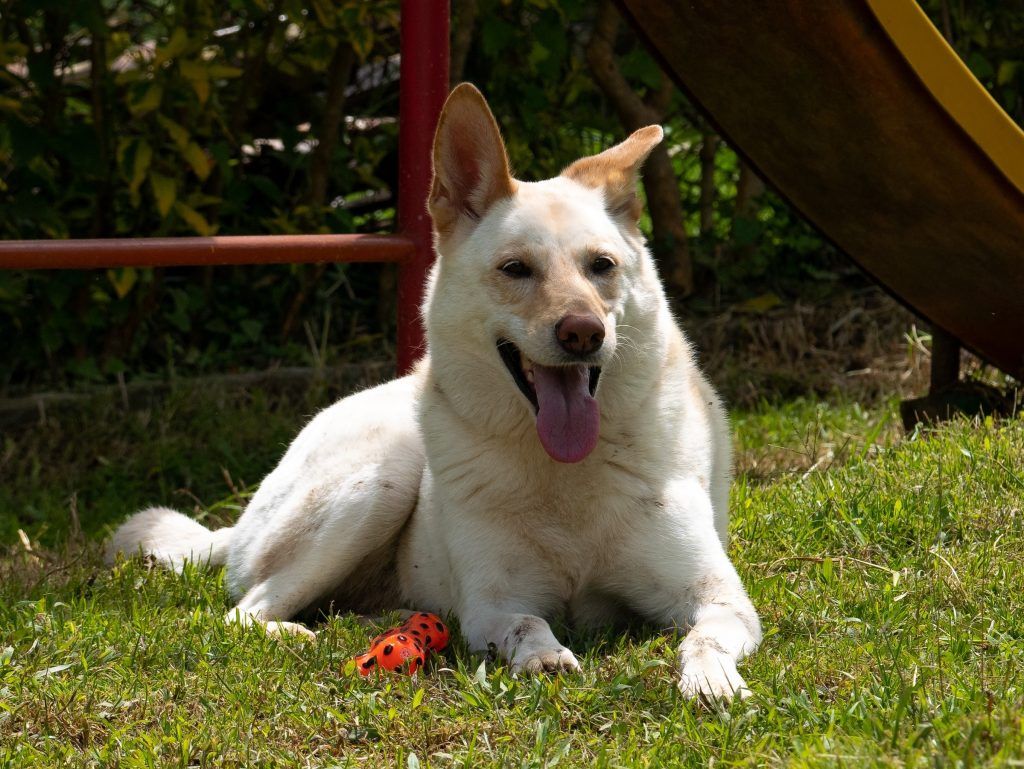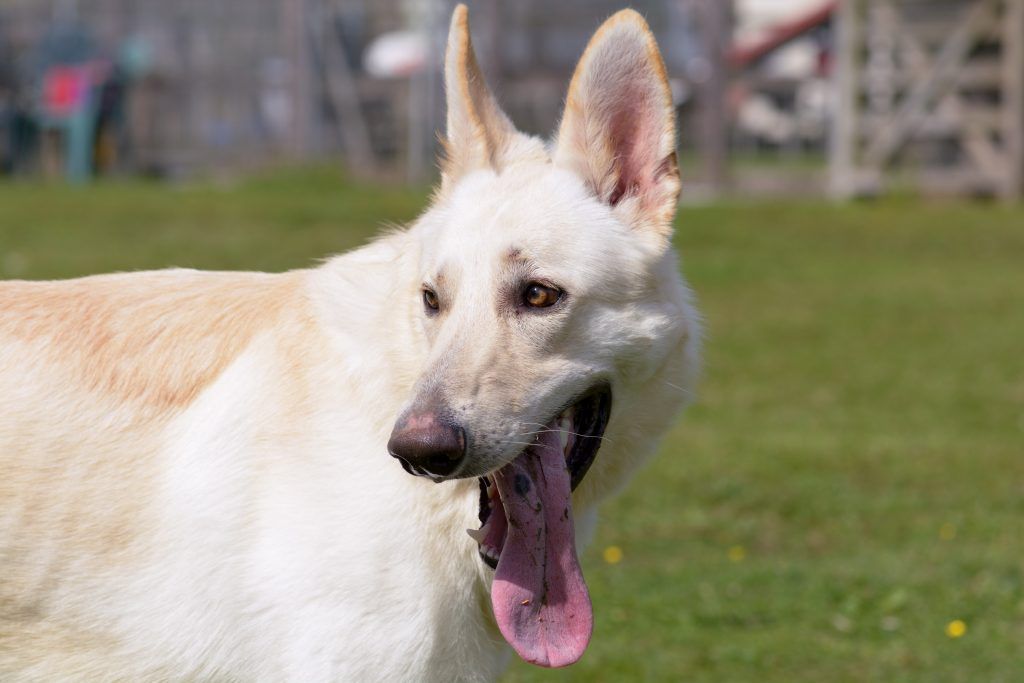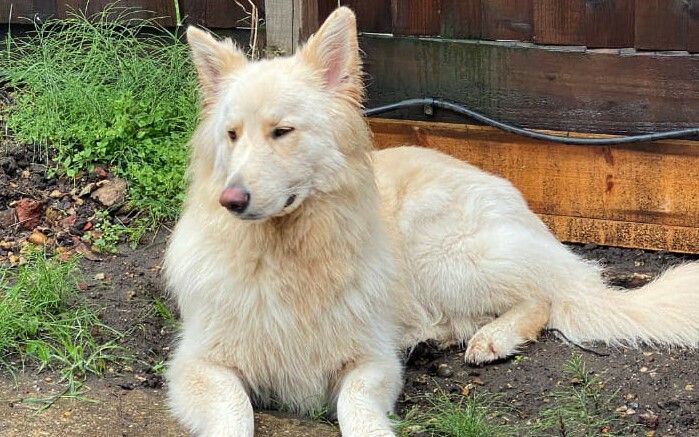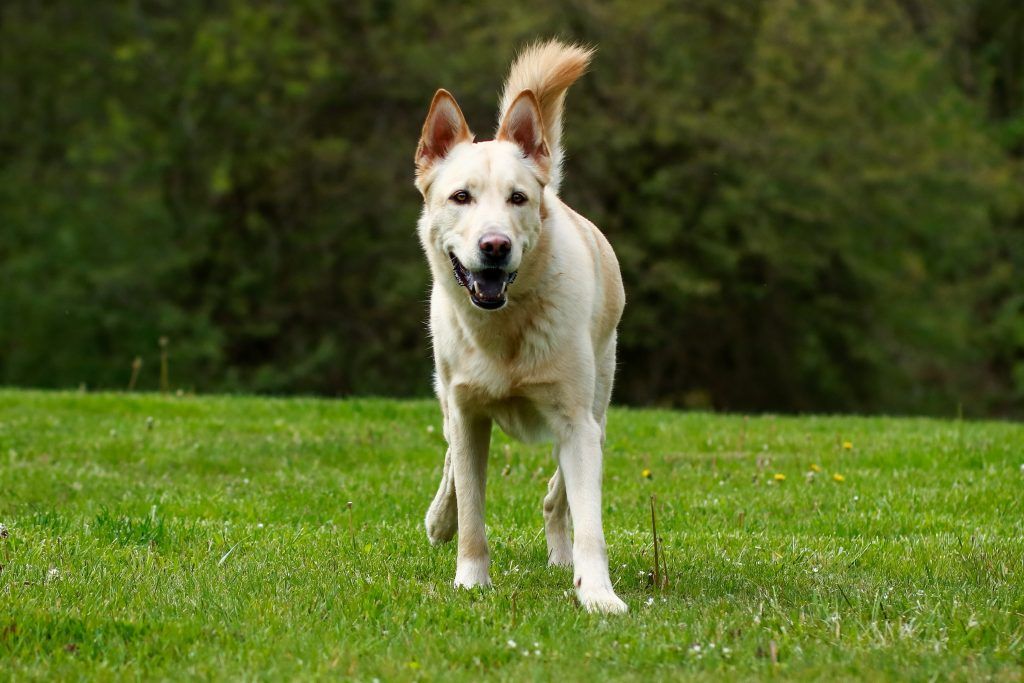Even non-dog people can pick a German Shepherd dog (GSD) out of a crowd. They are one of the most well-known and iconic dog breeds in the world. But did you know GSD’s can be blondes?
Most people don’t; in fact, there are quite a few coat colors German Shepherds can show that aren’t well-known.
Before writing this, I asked 50 people (friends and people on social media) if they knew German Shepherds could be blonde. Only 3 people said they had heard about it before, and none of them had seen one. Not a purebred anyway; blonde shepherd mixes are fairly common and a different thing entirely.
What are Blonde German Shepherds
One of the most unusual and unheard-of GSD coat colors is blonde. Blonde German Shepherds have a solid, or mostly solid, light cream or golden colored coat, often resembling the coloration of a Golden Retriever or Yellow Lab. Not to be confused with white-coated GSD’s.
Many people incorrectly assume that they are mixed with one of those breeds, but they are actually purebred German Shepherds with unique genetics.
They still have black paw pads and noses and can sometimes have dark markings on their ears, face, muzzle, feet, chest, or the tip of their tail.
Blonde German Shepherds are not a separate breed, sub-breed, or bloodline. Only a beautiful genetic mutation separates these blonde dogs from their typical colored counterparts.
Are Blonde GSD’s a Genetic Mutation
Blonde coats in German Shepherds are believed to be produced by a recessive gene that affects the production of melanin, the pigment that determines the color of a dog’s coat.
There are two types of melanin: eumelanin and phaeomelanin.
- Eumelanin produces black color
- phaeomelanin produces red color
Genes modify these pigments to produce different shades and patterns of colors.
Blonde German Shepherds have a genotype of ee at the MC1R gene, which means that they cannot produce eumelanin at all. Therefore, they only have phaeomelanin in their coat.
Unfortunately, this is only one piece of the puzzle. Instead of producing a solid red dog, they are blonde. So, there must be another gene, likely recessive, that goes into giving these dogs their golden color.
They Are Still Purebreds
Just because a German Shepherd is blonde does not mean it’s a mix.
Blonde is a naturally, albeit rare, occurring color in GSD’s. Two purebred German Shepherd parents, with the right combination of genetics, can produce blonde pups.

However, some breeders may avoid breeding blonde German Shepherds because they are not recognized by some kennel clubs or because they may raise doubts about their purity. Therefore, it may be harder to find reputable breeders who produce blonde German Shepherds.
Which Parent Colors Make a Blonde GSD
This is speculative because the genetics are still not fully understood.
It’s believed that to produce a blonde German Shepherd, both parents must carry the recessive ee gene at the MC1R locus, which means that they must either be blonde themselves (homozygous) or carriers (heterozygous) of the blonde gene.
The most likely parent colors to produce a blonde GSD are:
- Two blonde parents
- A blonde parent and a black-and-cream parent
- A black-and-cream parent and a carrier parent
- Two carrier parents
A carrier parent is a parent that has one copy of the dominant E gene and one copy of the recessive e gene at the MC1R locus. They can produce eumelanin in their coat, but they can also pass on the e gene to their offspring.
The most common carrier colors are believed to be:
- Black and tan
- Black and red
- Sable
- Liver
- Blue
8 Interesting Facts about Blond German Shepherds
Now that we’ve gotten the somewhat complicated part out of the way, here are some fascinating facts about these rare and beautiful dogs:
Not Albino – Blonde is it’s Own Color
Some people think Blonde German Shepherds are albinos. Not true at all! Albinism is a gene mutation that causes a complete lack of pigment in the skin, hair, and eyes. Albino dogs have pink noses, paw pads, and eyes.
They are also at an increased risk for sunburns, skin cancer, eye problems, and being born deaf.
Blonde German Shepherds have normal pigment in their skin and eyes, and only lack pigment in their hair. They do not have any health issues related to their coat color.

Incredibly Rare
Blonde German Shepherds are incredibly rare, and it’s due to two reasons.
- An unusual and not fully understood genetic combination is what causes the blonde color, making it difficult to purposefully breed for blonde coats.
- It’s also not a desirable color for show dogs. Professional breeds are not motivated to breed them because of this. They might also run the risk of some people questioning the quality of their dogs.
Most blonde German Shepherds are produced by accident or by hobby breeders who appreciate their uniqueness.
Not AKC Recognized
The AKC does not recognize blonde as a valid coat color for German Shepherds. The closest color they recognize is white, and it’s still considered a fault.
According to the AKC standard, German Shepherds can only have the following colors:
- Black
- Black and tan
- Black and cream
- Black and silver
- Black and red
- Sable
- Bi-color
- White
“Strong rich colors are preferred”
From the AKC’s official standard of the German Shepherd Dog
Blonde German Shepherds cannot compete in conformation shows. But, they can still participate in other AKC events such as obedience, agility, herding, tracking, and rally.
Doesn’t Affect Health
Blonde German Shepherds do not have health problems related to their coat color. They are just as healthy and robust as any other German Shepherd.

Like any German Shepherd, they are prone to the same health problems, such as:
- Hip Dysplasia
- Ear Infections
- Allergies
- Bloat
Older Dogs Might Not Stay Blonde
Most German Shepherd puppies are born all black, their coat slowly changes to whatever their normal color will be by about 8 weeks.
Blonde German Shepherds are born blonde and sometimes transition in reverse, darkening up over time. Including past the 8-week point. They won’t suddenly change into a black and red GSD, but they could lose the beautiful gold color for a darker version.
They can also develop darker patches or streaks in their coat, specifically on the back and tail. Over time, their hair follicles can start producing eumelanin (black color) instead of strictly phaeomelanin (red color).
This does not mean they are not purebred or have a health problem. It is just a natural variation that occurs in some blonde German Shepherds.
High Purchase Price
Usually, an undesirable breed standard leads to a lower price. The opposite is true with blonde German Shepherds.
Because of their rarity and difficulty in breeding, blonde German Shepherds are significantly higher in price compared to standard colors. They are also exceedingly difficult to find.
The price of a blonde German Shepherd puppy can range from $3000 to $5000 or more. A quick search shows that the average price of a non-rare colored German Shepherd at $2500, so blondes can be quite a bit higher.
Compared to the $750 I paid for my GSD almost 11 years ago, all these prices seem astronomical now.
Occurrence is an Anomaly
Going back to genetics again for a bit, blonde German Shepherds are considered something of an anomaly. Breeding specifically for the coat color is near-impossible, so when it does pop up in a litter of puppies, it’s like Christmas in July. If you’re into this sort of thing like I would be anyway.

The Blond GSD You Found Might be a Mutt
If you found a blonde German Shepherd in your local shelter/rescue or happened upon a stray wandering the streets – I hate to break it to you, but it’s most likely a mutt.
The extremely high rarity of blonde German Shepherds doesn’t mean there won’t one day be one abandoned, but it’s very unlikely.
Golden Retrievers, Yellow Labs, and occasionally Huskies are the most likely mixes that create a blonde shepherd-looking dog.
This is because some people may intentionally or unintentionally crossbreed different dogs to create designer dogs or hybrids. Some of these dogs may end up looking like blonde German Shepherds but have different personalities and traits.
The only way to know for sure if your blonde dog is a purebred German Shepherd is to buy one from a breeder you trust or get a DNA test.
























